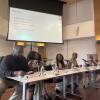In 1872, 13-year-old Hong Yen Chang came to the U.S. to be groomed as a diplomat. He earned degrees from Yale University and Columbia University's law school, and passed the bar exam.
He became the first Chinese-American lawyer in the U.S. in 1888, when he was admitted to the New York bar. But not all states were as welcoming. When Chang applied for a California law license in 1892, the state's Supreme Court denied his application citing bar association rules, which precluded non-citizens from joining. Chang was unable to become a citizen because of the Chinese Exclusion Act of 1882.
More than a century later, Chang's descendants petitioned for their relative to be granted posthumous bar admission and brought the case before the California Supreme Court.
In 2015, the California Supreme Court reversed the ruling. "Even if we cannot undo history, we can acknowledge it and, in doing so, accord a full measure of recognition to Chang's path-breaking efforts to become the first lawyer of Chinese descent in the United States," the judges wrote in their decision.
"That case got me thinking about the fact that Asian-Americans have been formally excluded from the legal profession as Chang was, and of course, [with] all the informal barriers," says California Supreme Court justice Goodwin Liu, who reviewed the case. He said he realized he hadn't seen a comprehensive study of how Asian-Americans came into the legal profession — so he took it upon himself to lead one.
In the study, Liu shows that though Asian-Americans are the fastest-growing minority group in the legal field, there's still a stark lack of Asian-American lawyers in top positions in this country.
In 2015, 10 percent of graduates at the top-30 law schools were Asian-American, according to the study. Yet they only comprised about 6 percent of federal law clerks and 4 percent of state law clerks. Compare that to white students, and you'll see a striking contrast: 58 percent of students from top-30 schools were white, but still landed 82 percent of all federal clerkships and 80 percent of all state clerkships.
Liu and his co-researchers also found that while Asian-Americans comprise 5 percent of lawyers in the U.S. and 7 percent of law students, only 3 percent of federal judges are Asian-American, and three out of 94 U.S. Attorneys last year were Asian-American.
The study noted that some obstacles Asian-Americans face include a lack of access to mentors, as well as stereotypes of Asians as being unable to assimilate or socially awkward.
"Whereas Asian Americans are regarded as having the 'hard skills' required for lawyerly competence, they are regarded as lacking many important 'soft skills,' " the researchers wrote.
The study also pointed out that there's a dearth of Asian-American lawyers in public service roles:
"It is notable that few Asian Americans appear motivated to pursue law in order to gain a pathway into government or politics. ... Greater penetration into these public leadership roles is critical if the increasing number of Asian American attorneys is to translate into increasing influence of Asian Americans in the legal profession and throughout society. A major challenge is to encourage Asian American lawyers to pursue public service roles and to eliminate barriers for those who do."
When asked to break out the data further by ethnicity, Xiaonan Hu, one of the researchers, told NPR that she noticed Filipino-American and Indian-American respondents were more likely to say they enrolled in law school to work in government or politics than, say, Japanese-American or Korean-American respondents. Two percent of respondents who were Japanese-American and 3 percent of Korean-Americans ranked the entry into government or politics as a top motivator for going to law school, compared to 11 percent of Filipino-Americans and 5 percent of Indian-Americans.
So what could account for this?
"It doesn't seem like it's as much about those groups [being] MORE interested in government and politics, but less averse to it," Karthick Ramakrishnan, a professor of political science at the University of California, Riverside, wrote in an email.
"For Filipino Americans, many of them made advancements in government and local politics in California and Hawaii, where they have large populations and there were relatively long-standing Filipino communities," Ramakrishnan, who also runs the project AAPI DATA, said.
"Indian Americans, by comparison, are much more recently arrived in the United States (with their population booming in the last 2 decades). That normally would mean that we would not expect them to be involved in politics. But, past research indicates that prior experience with democracy and high English proficiency tend to mean greater political participation."
And while there are rampant structural issues that need to be addressed, Chris Kang, former National Director of the National Council of Asian Pacific Americans, said that emphasizing role models can sometimes be powerful.
When Kang was working with the Obama administration as Pres. Obama's Deputy Counsel, he helped appoint federal judges. Kang said he and his team tried to highlight each new justice's ethnicity and gender.
"It wasn't just, 'the first Asian-American judge in the district,' but we really went and highlighted 'the first Vietnamese-American, the first Filipino-American,' " Kang told NPR.
Copyright 2017 NPR. To see more, visit http://www.npr.org/.




